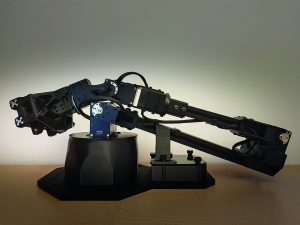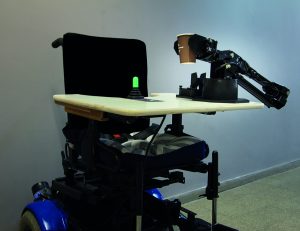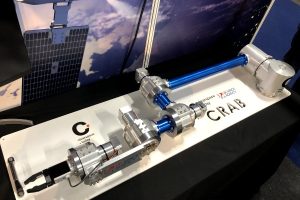
An early prototype of a robotic arm designed to assist patients with spinal injuries in performing daily tasks.
Patients with spinal cord or neuromuscular injuries resulting in limited mobility in their upper body could gain some independence if a trial being conducted at ALYN Hospital in Israel is successful. Small groups of patients at the paediatric and adolescent rehabilitation hospital will use a wheelchair fitted with a robotic arm powered by Intel’s Loihi neuromorphic chip. This uses adapted algorithms from Applied Brain Research.
The neuromorphic computing system can assess its immediate environment to understand where the robotic arm is in relation to an object, such as a cup, and calculate the trajectory and force needed for a specific movement. For example, such as to bring a cup of water to the wheelchair user’s mouth smoothly and replace it when finished.
The project uses a prototype robotic arm and neuromorphic computing to train machine-learning models in the same way the developing human brain learns; by seeing an image once and being able to recognise it from then on. Neuromorphic computing can automatically identify where the robotic arm is and calculate the movement required.
This differs from artificial intelligence, which is based on algorithms trained to perform specific tasks. Using neuromorphic computing eliminates many of the motors and controllers used in robotics to perform these tasks to ensure correct positioning and alignment, explains Mike Davies, director of Intel’s neuromorphic computing lab. This can reduce the bill of materials for specialist wheelchairs.
More benefits of neuromorphic computing are that less data is required to train machine-learning models and they consume less energy. Researchers expect that the real-time learning capability of the Loihi chip will allow them to implement adaptive control to enhance the arm’s functionality and the low power consumption will mean that the arm will need less frequent charging and is more practical for daily use over a longer period of time. Intel says that Loihi is up to 1,000 times more energy-efficient than general purpose processors.
Joystick operation
The wheelchair is equipped with a joystick that operates the robotic arm. In a year, the arm will be able to perform its own trajectory planning and be semi-autonomous through a 3D- camera mounted on the arm, says Dr Elishai Ezra Tsur, principal investigator of the neuro and biomorphic engineering lab at the Open University of Israel, which is leading the Intel Neuromorphic Research Community (INRC) project. The project is funded by Intel and Accenture Labs and conducted in collaboration with ALYN Hospital.
Using the robotic arm, the research team built the neural network model that controls the arm using the recurrent error-driven adaptive control hierarchy algorithm developed by Applied Brain Research. The combination had already demonstrated movements of a simpler robotic arm through complex paths, including handwritten words and numbers, with fewer errors and improved energy efficiency compared with more traditional control methods. The team deployed the completed algorithm on Intel’s neuromorphic hardware and tested the capabilities of the arm in readiness for the clinical trials with around 25 patients. The first trial group of five patients took place between April and June 2021.
Increasing independence
Applying assistive robotics to patients can increase a sense of independence for wheelchair users and reduce the time needed by caregivers. The clinical trial hopes to pave the way for a commercially viable, affordable, low energy, intelligent robotic arm for wheelchair users.
“Making these devices accessible, particularly to such young patients, can have a profound impact on their independence, improving the way they live,” observes Edy Liogosari, technology innovation growth and strategy lead and chief research scientist at Accenture.
“We believe that the development of a robotic arm based on neuromorphic computing can be a game-changer for people with disabilities,” adds Arie Melamed-Yekel, general manger of ALYNnnovation at ALYN Hospital. “It could make it easier for them to engage with the community, boost their independence and grant them new employment opportunities.”
The INRC neuromorphic robotic arm was given an honourable mention in Fast company magazine’s World Changing Ideas Awards 2021. These awards are for “Acknowledging concepts, prototypes and just launched ideas that… have the potential to change how we think about an issue.”
What is neuromorphic computing?
Neuromorphic computing mimics the human brain’s ability to learn about its environment and adapt behaviour in real time, expending minimal energy. Artificial intelligence (AI), on the other hand, uses algorithms trained for specific tasks that are used by artificial neural networks. These algorithms are developed using large amounts of data. They are used by artificial neural networks for training and inference tasks. Generally, AI cannot adapt to changes in an environment in real time, whereas a neuromorphic chip, typically an asic, uses artificial neural networks called spiked neural networks, which are modelled on the human brain’s neural network, sending signals when a neuron has reached its electrical charge threshold, rather than firing a signal with each propagation cycle.
Neuromorphic architecture is characterised by high-speed processing at low power consumption. Unlike the von Neumann architecture, it has a continuous transition rather than highs and lows from binary encoding. It also integrates storage and processing, which eliminates the bus bottleneck between the CPU and memory.
The chips can be digital, analogue or mixed. According to analyst Mordor Intelligence, analogue chips are closer to biological neural networks and use fewer transistors to emulate neurons than digital versions. Theoretically, says the company, analogue neuromorphic chips consume less energy and can extend processing beyond the allocated time slot to accelerate the processing speeds beyond real-time speeds.
The architecture of analogue chips, however, leads to high noise levels, making digital neuromorphic chips more precise.
The digital architecture is optimal for on-chip programming of algorithms with low energy consumption compared to graphic processor units. Mixed chips combine analogue’s lower energy with precision.
With the potential to achieve massively parallel brain processing at a low power budget of 10s of Watts, neuromorphic chips use in-memory computing for a dynamic, self-programmable operation.
Neuromorphic chips are used in medical applications, for example to improve the accuracy of medical testing, and in the automotive industry to develop Level 5 Autonomy vehicles, that is, fully autonomous, with no need for any human attention to controls or driving conditions.
The neuromorphic chip market is expected to experience 47% CAGR between 2020 and 2026, said Mordor, increasing from a value of $22.5m to $333.6m in this period.
 Electronics Weekly Electronics Design & Components Tech News
Electronics Weekly Electronics Design & Components Tech News





